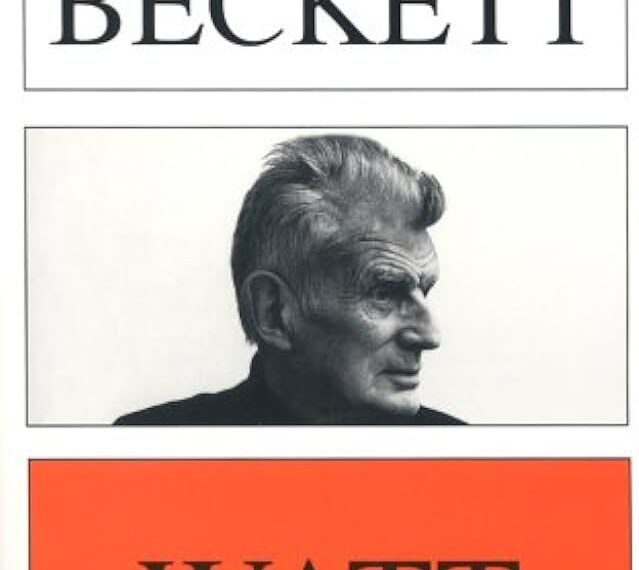The Beckett rejects the received logic of form and conventional structure
Samuel Beckett, an influential figure in 20th-century literature, is renowned for his avant-garde and experimental approach to writing.Beckett continuously questions and rejects the conventional structure and accepted logic of form in his works, especially in his plays and novels. His works are distinguished by their disjointed storylines, minimalist aesthetic, and dismantling of conventional dramatic and narrative components.
The Deconstruction of Language and Communication:
One of the most prominent ways Beckett rejects conventional form is through his deconstruction of language and communication. His plays, such as “Waiting for Godot,” are marked by repetitive and often nonsensical dialogue. The characters engage in circular conversations and wordplay, which subvert traditional expectations of meaningful and linear communication.
In “Waiting for Godot,” for instance, Vladimir and Estragon’s conversations are characterized by their inability to communicate effectively. They often fail to understand each other or the meaning of their own words. This deconstruction of language reflects the breakdown of conventional communication, emphasizing the difficulty of conveying meaning in an absurd and chaotic world.
The audience is forced to consider the limitations of communication and the ineffectiveness of language in describing the human predicament by Beckett’s rejection of traditional language form. His characters struggle with life’s basic absurdity, and linguistic deconstruction serves as a vehicle for expressing their existential distress.
Breaking Down Traditional Narrative Structure:
Beckett’s works also subvert traditional narrative structures. In his novels and plays, there is often a lack of linear plot development and a disintegration of the cause-and-effect relationships that are common in conventional storytelling. Instead, Beckett’s narratives are characterized by repetition, cyclical patterns, and a sense of stasis.
Also Read-
Happy Days Novel Summary by Samuel Beckett
Murphy Novel Summary by Samuel Beckett
Endgame Novel Summary by Samuel Beckett
For example, “Endgame” presents a narrative where Hamm and Clov’s actions are repetitive and circular, with no clear progression. Similarly, “Molloy” and “Malone Dies” offer fragmented narratives and disjointed episodes, challenging the reader’s expectations of a cohesive and linear story.
This rejection of conventional narrative structure serves to dismantle the idea of a coherent and meaningful plot. Instead, Beckett’s narratives reflect the experience of an absurd and disordered world, where life often lacks clear direction or purpose. By breaking down traditional narrative structure, Beckett forces his audience to confront the senselessness and chaos of human existence.
Theatrical Minimalism and the Absence of Setting:
In Beckett’s dramatic works, he embraces a form of theatrical minimalism that rejects the conventional elements of setting, props, and spectacle. His play “Not I,” for instance, features a spotlight on the actress’s mouth as she delivers a rapid and fragmented monologue. The absence of setting and visual context shifts the focus entirely to the spoken words, intensifying the impact of language on the audience.
This rejection of conventional theatrical elements highlights Beckett’s emphasis on the essential core of his works – the language and its power to convey the existential struggles and anxieties of his characters. By stripping away traditional staging and setting, Beckett allows his words to take center stage, often creating a heightened sense of isolation, absurdity, and existential crisis.
Themes of Isolation and Existential Despair:
The rejection of conventional form and structure in Beckett’s works is not merely an exercise in experimental writing; it serves a profound thematic purpose. Beckett’s characters are often trapped in isolated and desolate landscapes, both physically and metaphorically. The rejection of conventional structure reflects their existential isolation and despair.
In “Endgame,” Hamm and Clov are confined to a single, bare room, mirroring their emotional and existential entrapment. Similarly, in “Krapp’s Last Tape,” Krapp’s life is reduced to a series of recorded tapes, highlighting the passage of time and the inevitability of mortality.
By deconstructing form and structure, Beckett emphasizes the futility of human existence and the sense of hopelessness that pervades his characters’ lives. His rejection of conventional storytelling and theatrical elements serves to create an atmosphere of existential angst, where characters grapple with the meaninglessness of their actions and the limitations of their existence.
Time and Temporality:
Another aspect of conventional structure that Beckett challenges is the linear progression of time. In many of his works, time is fragmented, cyclical, or disordered. Characters often find themselves trapped in a perpetual present, unable to escape the repetitive patterns of their lives.
In “Waiting for Godot,” the characters wait for an elusive Godot without any clear sense of time or purpose. In “Footfalls,” the protagonist, May, relives moments from her life in a fragmented and non-sequential manner. These disruptions in the conventional flow of time contribute to the sense of existential stasis and the characters’ inability to move forward or find meaning.
Beckett’s exploration of time aligns with his rejection of conventional form, as he challenges the audience’s expectations of a linear and coherent narrative. Instead, he presents time as a complex and often bewildering force that contributes to the characters’ sense of futility and despair.
Metafiction and Self-Referentiality:
Beckett’s works also incorporate elements of metafiction and self-referentiality, further challenging conventional narrative structure. Characters in his novels and plays often reflect on their own existence, their roles as characters, and the act of storytelling itself.

In “Murphy,” the protagonist Murphy contemplates his role as a character within the novel, blurring the lines between fiction and reality. Similarly, in “Krapp’s Last Tape,” Krapp listens to recordings of his own voice, reflecting on his past actions and the act of recording.
This self-awareness and metafictional element in Beckett’s works serve to deconstruct traditional narrative conventions. It prompts the audience to question the nature of storytelling and the relationship between author, character, and reader. Beckett’s rejection of conventional form extends to the very act of storytelling, challenging established norms and inviting readers to engage with the text on a more reflective and critical level.
Absurdist and Existential Themes:
The rejection of conventional form and structure in Beckett’s works aligns with his association with the Theatre of the Absurd and his exploration of existential themes. Beckett’s characters often grapple with the absurdity of existence, the meaninglessness of human actions, and the inevitability of death. The rejection of traditional form serves as a means to convey these existential anxieties.
In “Endgame,” Hamm’s paralysis and Clov’s inability to sit down exemplify the absurdity of their situation. The cyclical and repetitive nature of their actions underscores the futility of their existence. Beckett’s characters frequently face absurd and irrational circumstances, and the rejection of conventional structure amplifies this sense of the absurd.
The existential themes in Beckett’s works, coupled with the unconventional form, challenge the audience to confront the human condition in all its complexity and ambiguity. Beckett’s rejection of conventional structure serves as a means to delve into the depths of existential despair and the inherent contradictions of human existence.
Conclusion
In Samuel Beckett’s literary works, the rejection of conventional form and structure is a deliberate and profound exploration of the human condition. Beckett’s innovative and experimental approach challenges the received logic of traditional narrative, language, and theater. His deconstruction of language, dismantling of traditional narrative structure, and theatrical minimalism serve as vehicles for deeper thematic and philosophical exploration.
Beckett expresses themes of loneliness, existential dread, communication failure, and the absurdity of human life through his rejection of conventional form. His characters, who reflect the intricacies and paradoxes of the human experience, struggle with the limitations of language and storytelling.
Beckett’s works demand active engagement and interpretation from the audience, inviting them to confront the mysteries and uncertainties of existence. His legacy in 20th-century literature and theater is marked by his audacious rejection of established norms and his commitment to pushing the boundaries of artistic expression.
FAQ.
What are some of Samuel Beckett’s most famous works known for their rejection of conventional form and structure?
Beckett’s most famous works that showcase his rejection of conventional form include “Waiting for Godot,” “Endgame,” “Krapp’s Last Tape,” “Not I,” and his novel “Murphy.” These works are celebrated for their experimental approach to language, narrative, and theater.
How does Beckett’s rejection of conventional form contribute to the themes of existentialism in his works?
Beckett’s rejection of conventional form aligns with existential themes by emphasizing the absurdity of existence, the futility of human actions, and the inherent isolation and despair experienced by his characters. His unconventional approach serves as a vehicle to explore these existential anxieties.
What is the significance of Beckett’s use of metafiction and self-referentiality in his works?
Beckett’s use of metafiction and self-referentiality challenges traditional storytelling and blurs the lines between fiction and reality. Characters in his works often reflect on their roles as characters, inviting the audience to consider the nature of storytelling and the relationship between author, character, and reader.
How does Beckett’s theatrical minimalism contribute to his rejection of conventional form?
Beckett’s theatrical minimalism, which often includes the absence of elaborate settings and props, shifts the focus to language and performance. This minimalism emphasizes the power of words to convey complex themes and emotions while rejecting the conventional spectacle associated with theater.
What is the lasting impact of Samuel Beckett’s rejection of conventional form on literature and theater?
Beckett’s rejection of conventional form has had a profound and lasting impact on literature and theater. It has influenced subsequent generations of writers and playwrights who have sought to push the boundaries of artistic expression and explore the depths of human existence through innovative and experimental means. Beckett’s legacy remains a cornerstone of avant-garde literature and theater.



